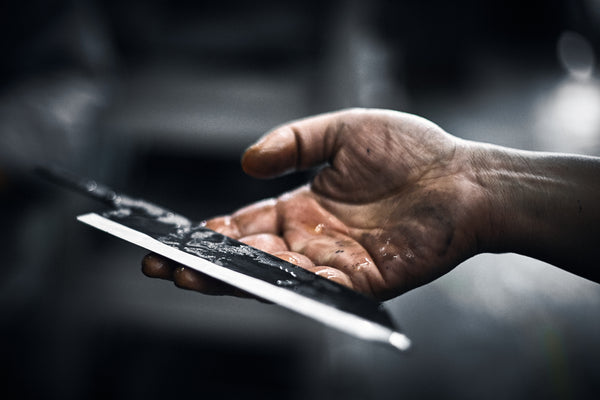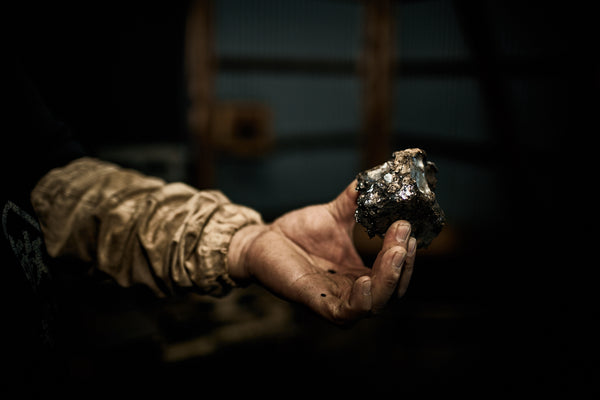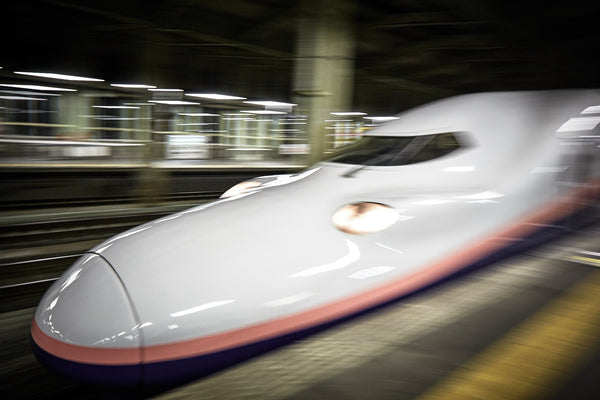
Ever since when I was a young boy I was captivated – as were probably most of my peers – by warrior knives, swords and daggers. The sword of all swords and the king of all blades was made from mysterious steel and came from a faraway mystical country in the East. It was created in dusky smithies where the knowledge of blacksmiths’ skilful hand-crafting has been passed down through generations for thousands of years. This was, of course, the Japanese katana.
Years went by and passion for the blades remained. The focus, however, shifted from the field of battle in a child’s imagination to the cutting board of a grown man. Today, as the owner of a small business selling kitchen knives, I deal on a daily basis with various types of steel and forging techniques, I sharpen knives and study their shapes, I buy books on blacksmithing, and, most of all, I do a lot of cutting, chopping and testing.
The deeper I delve into the world of sharpness the more I realize that Japanese blacksmiths, by employing special production techniques and types of steel, still remain the masters of the enigmatic sharpness which can rival that of katana.
So, Japan. Go figure. The idea for a trip to Japan was set in motion by my friend Mitja Kobal, professional photographer, when he simply suggested one day that we should go visit “my” blacksmiths in Japan: “... You’ll get to see how they really work and I can snap a few pictures?” Wow. My mind started racing and I also began mulling over the facts that Mitja is not only a brilliant photographer but that he also studied Japanese, lived in Tokyo for a while, knows his way around Japan, travelled to many corners of the world, and, above all, he is a fine person to enjoy a beer with even in Ljubljana. It was like hitting a nail on the head. Let’s go!

But the thought that really fired my imagination when deciding if I should actually travel to Japan was visiting “my” blacksmiths. And this is story that goes further back – and forward. A year ago, Bine Volčič and I had already sown the seeds of an idea about a Slovenian-Japanese knife but we did not know that then yet. It all started with steel and, as every great idea, it came about spontaneously. Besides selling kitchen knives, my job also involves sharpening them. The more professional the cooks are and the more they cook, the more perfectionist they are and the more they sharpen their knives! And, of course, Bine is very professional, Bine is a perfectionist, Bine fervently sharpens his knives.
Our story began when I suggested one evening that he should test a blade made from a new type of steel which I got very excited about: “Hi Bine, I have this special knife made from a new kind of very cool steel – ZDP-189. Would you like to test it?”

Japan is famous for producing quality steel since the times of the samurai. The country is divided into 47 prefectures in eight regions and has one metropolis – Tokyo. Shimane Prefecture with the capital Matsue located in the south-west of the main and most populous Japanese island Honshu has been the centre of steel production in the country since ancient times.
In Shimane, the ground is rich with iron sand. The town of Yasugi is surrounded by forests and has plentiful reserves of iron sand which contains iron (Fe) and is smelted in furnaces fuelled by charcoal which is made from trees and contains carbon (C). Iron and carbon are key ingredients for producing steel. In the times of the samurai, the Japanese perfected the art of steel-making.
Tatara is a traditional furnace used for smelting iron and steel. In this clay vessel, a charcoal fire is started and, over the next few days, several layers of charcoal and iron sand are added. When the furnace cools down, the clay tube is broken and what remains at the bottom is steel bloom known as kera. If kera is large enough and if the craftsmen maintained the correct temperature, it contains a small amount of bright silvery alloy called tamahagane (which translates into “round and precious steel like a gem”).
This is a superior type of crude steel with the potential of being transformed by an experienced smith into a real katana’s blade – the hardest, the most flexible, the lightest and the sharpest blade.

The ancient tatara process was later replaced by modern steel production imported from the West. And just like with many other things imported to Japan, it became one of the best in the world owing to Japanese work culture, precision, commitment and ancient knowledge of steel-making. And to this day, in the same town of Yasugi in Shimane prefecture, Yasugi Special Steel, the flagship subsidiary of Hitachi Metals Ltd., remains faithful to its steel-making tradition and is committed to the development and production of special types of steel.
The subsidiary is known around the world, especially for its very hard tool steel and new generation steel, among them also ZDP-189 steel which is among the hardest in the world and from which only few experienced blacksmiths can forge a kitchen knife. This means that our kitchen can be a home to our very own katana made from modern-day tamahagana steel and by experienced Japanese craftsmen.
But let us not get ahead of ourselves. We still have a long way to go. Let us first embark on a trip to Japan.
The date of departure drew nearer, our travel plans were outlined, but we still faced a major hurdle. We sent the development department of large metallurgical corporation Hitachi an e-mail along the lines of: “Dear sirs, we are curious Slovenian lads who wish to find out as much as possible about your newest type of steel: what’s it like, how do you produce it etc.?” We also sent an e-mail to the secretive Japanese forge masters at the Yoshida smithy: “Hi, we are interested in your techniques of processing this special steel. Could we document everything in detail on photographs?” The replies, as you can imagine, were not very encouraging despite my lyrical convincing technique. Therefore, I must express my sincere gratitude to the Japanese embassy in Slovenia which, with its recommendations and direct communication, helped us open the door to the mysterious world of Japanese blacksmiths.

And so we found ourselves on the plane. After our stopover in London, we boarded our eagerly anticipated long-haul flight – 11 hours to Tokyo where the local time was 8 hours ahead of ours. We knew that we would take it slow. We gave ourselves 2 days to adjust to the new rhythm and environment.
After our “rest” in Tokyo, we planned to travel over the Honshu Island to Niigata, a little further north on the coast of the Sea of Japan, the home of our first blacksmith TOJIRO. From there, we would travel by the shinkasen or the Japanese bullet train to Osaka where we would set up a base for a few days and take daily trips to various kitchen knife smithies, grindstone producers, knife sharpeners and knife shops.
Our goal was to broaden our rudimentary knowledge of Japanese steel, production techniques and the forging of kitchen knives before reaching our two final stops in Saga: the Yoshida Hamono smithy and the steel manufacturing facility of Hitachi Metals, Ltd. This is where we would focus on kitchen knives made from ZDP-189 steel.

In Japan, distances can be overcome in a supremely elegant way. The shinkasens are frequent and their delays are recorded in seconds. These high-speed trains are very comfortable and, above all, extremely fast – they can easily travel with speeds up to 300km/h. The ticket, however, is quite expensive; hence most of the Japanese opt for plane travel. Tourists have the option of buying an inexpensive multi-day JR Pass but it must be purchased a few weeks prior to visiting Japan and is then sent to your home. Buying the ticket at the “tourist” price is not possible when you already arrive in the country.
Hotels are rather expensive so we decided to book smaller apartments via the Airbnb on-line service. Prices are moderate, owners very kind and reliable, only the size of floor space is a little different in Japan. The size of an entirely functional and equipped apartment for 2 can start at mere 13m². A 20m² flat is already considered plush. Even so, there is nothing to worry about: life on 13m² can be comfortable and practical.

If you are a foodie, you will find Japanese food very exciting as every meal can turn into a little adventure. The lovers of fish and sea food will probably fare better. When returning home, however, you will probably already miss a good slice of home-made bread. Food was the very thing that helped me learn more about the essence of kitchen knives and Japanese steel. Sushi, sashimi, yakiniku, soba etc.
Most of Japanese cuisine, if we leave out rice, is based on raw fish and vegetables cut into bite-sized pieces. The perception of sharpness in Japan probably holds the key as to why it is precisely Japanese knives that are the first choice of chefs around the globe. To the Japanese, sharpness traditionally entails the concept of taste and freshness, which also explains their primary goal in maintaining a blade’s sharpness – to cause the least damage to the cell walls in meat and vegetables.
This is the only way to reduce the loss of the succulent ingredients in cells and in turn to preserve freshness and taste. The finer the sharpness, the tastier both fresh and prepared food.

And so our days started to repeat themselves, although in a very interesting way. The morning in Osaka consisted of a typical rush (read: getting lost) on the metro, worrying about not missing the agreed appointment at the smithy (in Japan, being late is not exactly polite!), a tour of the smithy and work processes, conversations about steel, knives, forging techniques, taking a few photos etc. And if the day ended well and we did not ask too many “dumb” questions, we then visited the izakaya, a local bar where the sushi master wielded the knife of “our” blacksmith. These evenings spent savouring local delicacies and admiring the cutting skills of the sushi master, immersed in relaxed conversations with the smiths, revealed another side of the story.
Sushi master is a distinguished title and a respected profession. Each and every bite of sashimi we tasted was attended to with several different blades: for filleting, removing skin and final cutting. Every cut requires undivided attention because one wrong move would result in discarding food. The basis of such process and, of course, good sashimi is the highest level of sharpness possible.
Taking care of knives is naturally part of the work process. Daily sharpening, cleaning the blade between individual cuts, oiling the blade after using it, correct storage etc. To sum up: this is serious business. Accordingly, fine sharpness is the cornerstone of Japanese cuisine. The finer the sharpness of the blade, however, the more susceptible is to breaking and rusting, at least as far as traditional types of steel are concerned. The best sushi chefs therefore take extremely good care of their knives and dedicate so much time to them that they would probably be given the sack in any average Slovenian kitchen.

Our reconnaissance days were slowly coming to an end and, equipped with new knowledge, we continued our travel southward. Our next stop was our final destination. And this is where we agreed to make the first Slovenian-Japanese knife ZDP-189 which was conceived by me and Bine Volčič when we first tested this steel.
Yoshida Hamono is a small, family-owned smithy in the town of Saga in the southern island of Japan Kyushu. This is where they used to make katanas and even Shigeru’s late grandfather made one or two swords a year. Now they stopped making swords and specialized in two different types of tools: the younger brother mostly makes gardening tools, whereas Osamu san and his nephew Shieru san decided to carry on grandfather’s tradition and applied it to kitchen knives. What distinguishes them from the rest of blacksmiths is that, besides using traditional types of Japanese steel, they recently started to use the Hitachi superior quality ZDP-189 steel.
Bine already tested the first sample. And you can guess what his response was. “A-m-a-z-i-n-g!”

We arranged for a longer stay at the Yoshida smithy and agreed to make one kitchen knife together from start to finish. Mitja was allowed to photograph the details of entire process and I was able to get the answers to all my questions. You probably already gathered that the basis of the knife would be ZDP-189 steel.
See our Yoshida Hamono collection
What followed were some of the best days of observing how the knives were forged and all the pieces of Japanese work culture really started to come together for me. In its essence and at first glance, forging is a simple process also as far as kitchen knives are concerned: by delivering blows with a hammer we change the shape of the red-hot metal and, when we achieve the final shape of the blade, we have to heat-treat and temper the steel so it assumes the desired characteristics. Even the first step of delivering the blows or forging the steel with a hammer is reserved only for experienced craftsman in Japan. The masters or fathers decide when they will let their sons take over the craftsmanship. Usually, when they gain enough experience.

The secret lies in details, practice and concentration. In all the workshops I visited, the blacksmiths were over 60 years old, sometimes over 70, and their sons with salt-and-pepper hair took care of more everyday business operations. Every time I asked when would the hammer find its way to its successor, the answer was tactful: “A few more years, perhaps then.” After the forging process is finished, the steel is treated with heat. The procedures are incredibly precisely controlled: heating, cooling, freezing, slow heating to room temperature, cold forging. Metallurgical science entails exact instructions for treatment and, on the basis of many years of experience (and countless errors), only the best craftsmen dare to tailor it in the last years of their work – and this is when the magic happens.
The end result of our travel is also pure magic. An idea was turned into a reality and the Slovenian-Japanese knife saw the light of day. It is called ZDP-189. Do you still not understand the main secret of the Japanese ZDP-189 steel? Well, it is the hardest and, yes, its sharpness is fine. Or, as the Japanese blacksmiths would say: “Take it slow, one day you’ll understand.”

Text: Luka Grmovšek / Photos: Mitja Kobal
